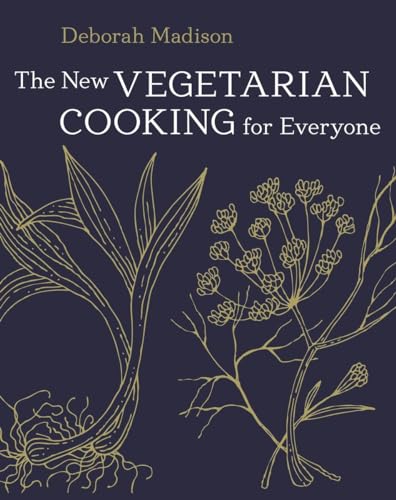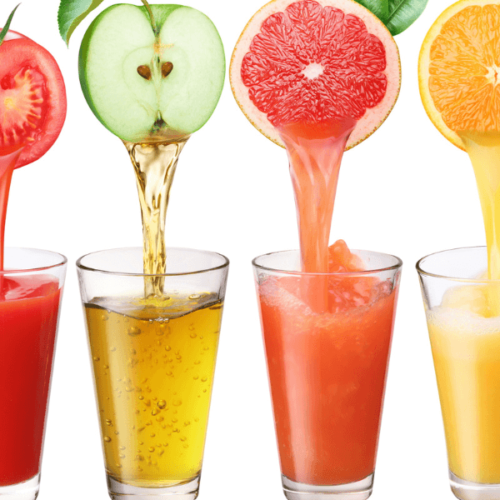To find vegetarian recipes (that are both healthy and delicious) can be a daunting task for both vegetarians and non-vegetarians alike.
When I was a vegetarian many years ago, I had SUCH a hard time finding food that was both tasty AND healthy for me to eat. I soon discovered that eating a vegetarian diet by merely surviving off of soy-based, meat-alternative products was NOT the best path forward (…Hello, skin fare ups and stomach pain!).
It was at this point that I dug into the incredible world of vegetarian recipes and discovered how absolutely yummy and delicious they can be. I then started creating this “How to Find Vegetarian Recipes” guide as my go-to resource for both myself and for anyone else that needed it.
I soon realized how eating this way gave my gut the beneficial bacteria it needed to thrive, and soon after it became one of my essential gut health habits that I ALWAYS encourage others to try.
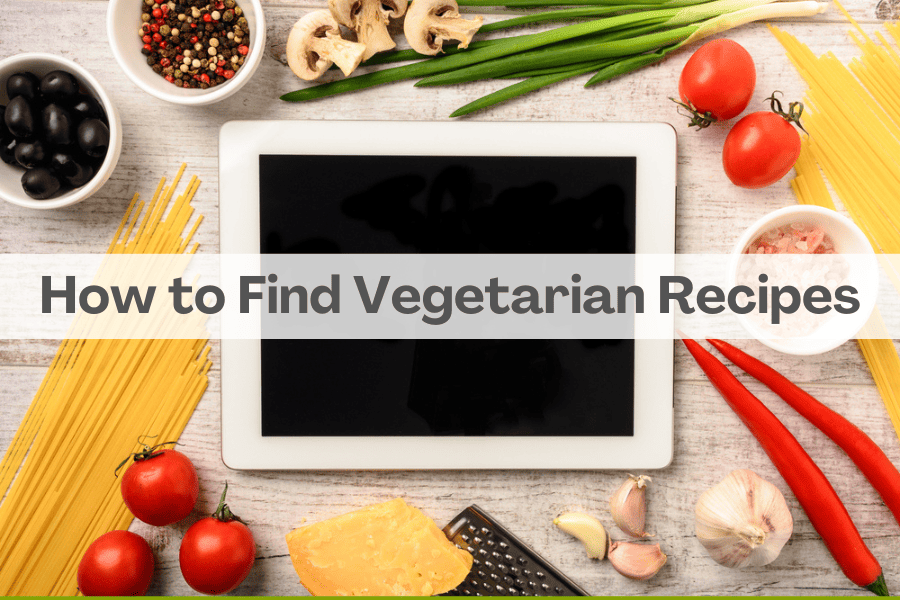
So, are you ready to dive into the delicious world of vegetarian cooking? Whether you’re a seasoned vegetarian or just looking to add more plant-based meals to your repertoire, this blog post will guide you through the process of finding amazing vegetarian recipes, mastering cooking techniques, and creating your own mouth-watering signature dishes.
Let’s explore an insider look on how we find vegetarian recipes and embark on a flavorful journey together!
This blog is all about “How to Find Vegetarian Recipes”.
Short Summary
- Enjoy delicious vegetarian recipes and discover the health & environmental benefits of a vegetarian lifestyle.
- Unlock flavorful dishes with specialized cookbooks, magazines, blogs & social media platforms.
- Experiment with ingredient swaps, fresh herbs/spices and cooking techniques to create nutritious meals!
Vegetarian Diet Benefits
Everyone has different reasons for eating vegetarian. And everyone’s reason for eating that way is truly okay.
For me, it began with a PETA cookbook many moons ago, that I bought at an Earth-Day festival in San Diego. After seeing pictures of abused animals all around the PETA booth, I dropped meat from my diet (almost) instantaneously. Yes, PETA very much has their marketing down pat 🙂
So, while my journey started with a “anti-animal cruelty” stance, it slowly morphed into a “save-the-planet” motivation, followed by eating that way as a generally healthy lifestyle.
For the most part a well-planned vegetarian diet can significantly reduce the risk of chronic diseases, such as heart disease, diabetes, and obesity, while also lowering cholesterol and blood pressure. Furthermore, it contributes positively to the environment by reducing greenhouse gas emissions, conserving water, and making efficient use of land.
So, not only will you be enjoying delicious vegetarian meals packed with colorful veggies and fresh herbs, but you’ll also be contributing to a healthier body and a greener planet.
Discovering Your Favorite Vegetarian Recipe Sources
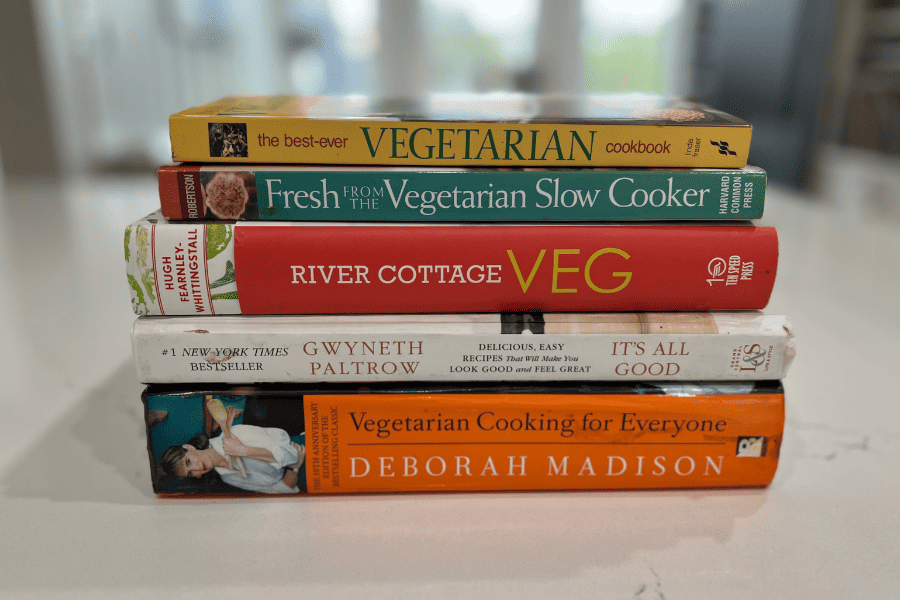
The first step in your vegetarian cooking journey is to find a wealth of scrumptious recipes. But where to begin? Fear not, as we have you covered.
Cookbooks, magazines, blogs, websites, and social media platforms are excellent sources for tasty vegetarian recipes that incorporate fresh herbs like fresh basil and an array of flavorful ingredients.
Get ready to explore this treasure trove of easy vegetarian recipes that will soon become your go-to favorites.
Cookbooks and Magazines
To find the best cookbooks and magazines for vegetarian recipes, look for publications that specialize in vegetarian cooking or those that have a wide range of vegetarian recipes.
Personally, I have a HUGE addiction to buying cookbooks. I am not sure what it is. Whether new or used, I am always drawn to new and interesting ways to prepare meals. And in our house, once a cookbook is put into our “Insider” group of cookbooks…then, they are “IN”! And, we whole-heartedly reference our favorite cookbooks regularly. Especially when forming our monthly meal plans!
Here are some of our FAVORITE (mostly) vegetarian cookbooks to check out:
1. The New Vegetarian Cooking for Everyone (by Deborah Madison)
This book is a staple recipe book for MANY of us living in the Bay Area, regardless of if we are vegetarian. Written by the renown chef, Deborah Madison (of the Greens Restaurant), this book is easily one of the world’s most popular vegetarian cookbooks, winning both a James Beard Foundation award and the IACP Julia Child Cookbook of the Year Award.
One of the things that I especially love about this cookbook, is that the recipes are not overly complex. Plus, they are often made up of “simple” ingredients that are commonly stored in and around the house. It’s great. I HIGHLY recommend this one!
2. It’s All Good (by Gwyneth Paltrow and Julia Turshen)
I am fairly certain that I have mentioned Gwyneth Paltrow’s “It’s All Good” cookbook over 100 times on this blog. It’s literally THAT good. Even though this one is NOT 100% vegetarian, there are still so many great veggie recipes in it that I definitely think it deserves to make this list.
This recipe book is a collaboration between Ms. Paltrow and Julia Turshen, New York Times best-selling cookbook author. This book does such a fantastic job of not using ingredients that are often “inflammatory” in nature. Meaning that most recipes are free of soy, dairy, gluten, etc. It is one that I often follow when doing any type of “Clean Eating” or elimination diets.
Pretty much all of the recipes that I’ve made with the It’s All Good recipe book have been absolutely delicious. Some of our favorites are the Beet, Fennel + Apple Soup, and the Easiest (Vegan) Posole. Yum!
3. River Cottage Veg (by Hugh Fearnley-Whittingstall)
This River Cottage Veg cookbook is also SO good and delicious. Plus, it is a beautifully designed cookbook as well!
Regardless of if you eat 100% vegetarian, or like to eat veggie dishes on the side, this recipe book is a must try. As a champion of sustainable foods, the author, Hugh Fearnley-Whittingstall, gives us over 200 vegetable-based recipes, with nearly 60 that are vegan.
This is ANOTHER cookbook, where out of the 10 or so recipes that we have made…nearly all of them have been absolute winners. This book has SLIGHTLY more complicated ingredients than some of the others, but nothing too complex. Meaning, you might need to plan ahead and go shopping for some of the ingredients versus using what you already have on hand. Totally worth it in our opinion.
4. The Forest Feast (by Erin Gleeson)
For anyone who loves “cabin life” and connecting to the outdoors, this recipe book is for you!
This cookbook features appetizers, cocktails, salads, and other vegetable dishes as main courses and is DEFINITELY worth adding to your cookbook arsenal.
Based upon the author’s popular blog, The Forest Feast, this vegetarian cookbook has over 100 vegetarian recipes that are mostly made from 3-4 ingredients. You can’t get much more minimalistic that this! I definitely like to use some of these recipes when hosting various events (i.e-friend gatherings, holiday parties, etc.) because they are SO simple to make. And delicious too!
So, grab a few cookbooks and/or magazines, and let the culinary adventure begin!
Blogs and Websites
Blogs and websites are also a treasure trove of vegetarian recipes and cooking tips.
Some of our recommendations of the Best Vegetarian Blogs include:
These blogs offer a variety of exciting recipes and cooking tips, such as vegan baking, plant-based meal ideas, and vegetarian cooking techniques.
However, do NOT limit your search to only vegetarian blogs or websites for your recipe search. Many of the top food and recipe websites have a plethora of vegetarian or vegan recipe options.
Some of our favorite Non-Vegetarian Recipe Blogs (that have vegetarian options) are:
So, get ready to bookmark your favorite blogs and websites for a constant source of inspiration.
Social Media Platforms
Social media platforms like Pinterest and Instagram are also an excellent way to find delicious vegetarian recipes. You can easily search for recipes, follow accounts that specialize in vegetarian cooking, and save your favorite recipes for later.
Pretty much the same blogs that I mentioned above are the ones that I also follow on social media. Especially Instagram. Instagram is one of the perfect social platforms for food-related content. Who doesn’t love watching food-related videos for inspiration?
Some more of our favorite vegetarian social media accounts (not included above) are:
- @sweetpotatosoul
- @ohsheglows
- @elavegan
- @earthyandy
- @onceuponapumpkin
- @hotforfood.
How about you guys? Let us know which social accounts that your follow! We are ALWAYS looking for new and interesting places for food inspiration.
Mastering the Art of Vegetarian Cooking

Now that you have an abundance of recipes at your fingertips, it’s time to master the art of vegetarian cooking. This involves learning how to make ingredient swaps and substitutions, using fresh herbs and spices to elevate the flavors, and exploring various cooking techniques like roasting, sautéing, grilling, and steaming.
With a little practice and creativity, you’ll be whipping up easy vegetarian recipes that are not only healthy but also incredibly delicious.
Ingredient Swaps and Substitutions
One of the joys of vegetarian cooking is experimenting with ingredient swaps and substitutions.
One of the most common things that we do with recipes is replace the meat with flavorful plant-based proteins like tofu, tempeh, and seitan, or use dairy-free milk alternatives like almond or oat milk for a creamy finish. You can even try using cream cheese in some recipes for a rich and satisfying taste.
When adjusting recipes to accommodate dietary restrictions, you can start by substituting the “problematic” ingredient with a suitable alternative.
However, this switch does not work for every recipe.
The good news is that more and more websites provide ways to transform their non-vegetarian recipes into a good-tasting vegetarian versions. Because if a dish is very meat-heavy then swapping out a steak for let’s say tofu, doesn’t always work. That is, unless you know which spices and flavors to add to make up for that substitution.
Using Fresh Herbs and Spices
Using fresh herbs and spices can bring a whole new dimension of flavor and complexity to your vegetarian dishes. Aromatic herbs like basil, oregano, thyme, and rosemary, combined with spices such as cumin, coriander, turmeric, ginger, garlic, and chili peppers, can transform a simple meal into a taste sensation.
Start with a small amount and add more as needed to achieve the perfect flavor profile for your dish.
The more that you cook vegetarian recipes, the more that you start to understand what works and doesn’t work from a spice perspective. Practice and repetition definitely makes perfect.
Cooking Techniques
Different cooking techniques can bring out the best in your vegetarian ingredients.
Roasting vegetables, for example, enhances their natural sweetness and adds a delightful caramelization. Sautéing, grilling, and steaming are also fantastic techniques for cooking vegetarian dishes, each offering their own unique flavors and textures.
Don’t be afraid to experiment with different methods and ingredients to create a wide variety of delicious vegetarian meals.
How to Make Balanced and Nutritious Vegetarian Meals
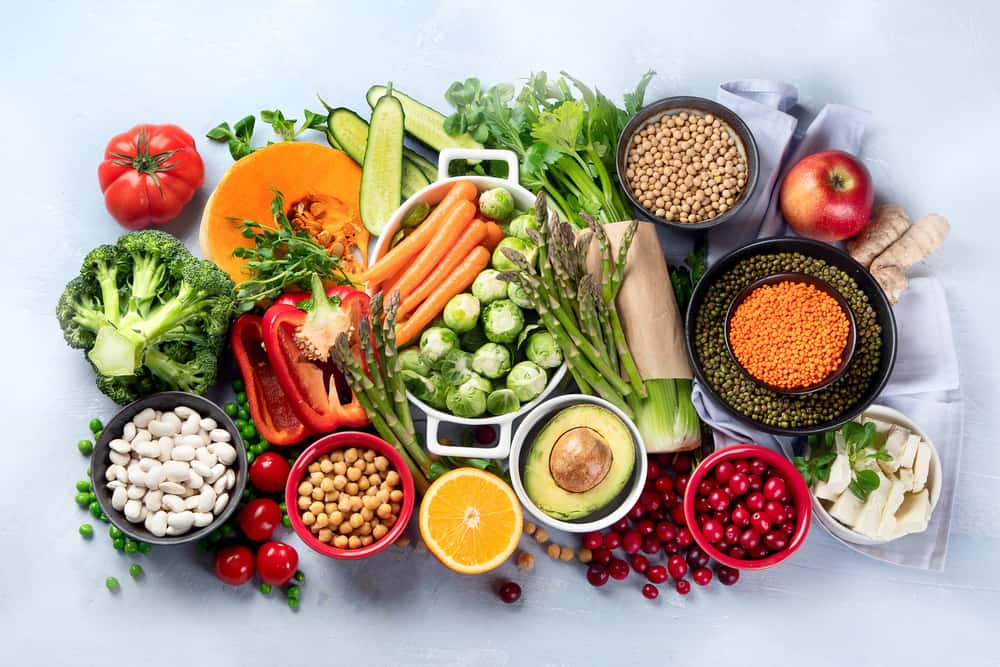
A balanced vegetarian meal consists of a variety of protein sources, vibrant vegetables and fruits, as well as whole grains and nutritious fats. By including these components, you’re not only creating delicious meals, but also ensuring that you’re getting all the essential nutrients your body needs.
From protein-packed beans and lentils to colorful veggies like sweet potatoes and green beans, the possibilities for creating healthy and satisfying vegetarian meals with black beans are endless.
#1: Protein Sources
When planning your vegetarian meals, it’s important to include a variety of plant-based protein sources, such as beans, lentils, tofu, tempeh, nuts, and seeds. These protein-packed ingredients not only provide the essential amino acids your body needs, but also add delicious flavors and textures to your dishes.
#2: Colorful Vegetables and Fruits- Eat a Rainbow!
Eating a variety of colorful vegetables and fruits is essential for good health, as they provide vital vitamins, minerals, and antioxidants. Adding colorful vegetables and fruits to your meals not only makes them visually appealing, but also ensures that you’re getting a wide range of nutrients.
“Eating a Rainbow” is generally my goal when making most vegetarian meals, especially salads. And, it should be yours too! Aiming to include a variety of colorful fruits and vegetables ensures that you will also receive as many different types of vitamins and nutrients as possible. Not only will this help boost your nutrition for your gut health, but it will also improve your vitamin intake overall!
So, be creative and mix it up by adding an array of colorful veggies and fruits to your salads, stir-fries, soups, and smoothies.
#3: Whole Grains and Healthy Fats
Whole grains and healthy fats are invaluable components of a balanced vegetarian diet.
Whole grains, such as quinoa, oats, and brown rice, provide essential nutrients like fiber, B vitamins, and minerals, while healthy fats, found in avocado, olive oil, nuts, and seeds, provide essential fatty acids and help to keep you feeling satisfied.
By incorporating these wholesome ingredients into your vegetarian meals, you’re not only creating delicious dishes, but also supporting your overall health and wellbeing.
Customizing and Experimenting with Vegetarian Recipes
Now that you have a wealth of vegetarian recipe sources at your fingertips, it’s time to get creative and make them your own!
Customizing and experimenting with vegetarian recipes allows you to tailor each dish to your taste preferences and even create your own signature dishes.
In this section, we’ll share some tips and tricks for adjusting spice levels, incorporating your favorite ingredients, and creating your own unique and delicious vegetarian meals.
Adjusting Spice Levels
Spice levels can be a very personal preference, and learning how to modify the spice levels in vegetarian recipes to suit your taste buds is key to enjoying the dish. Start with adding a small amount of spices like garlic powder or black pepper and gradually increase it until you achieve the ideal flavor profile for your dish.
Remember, it’s always easier to add more spices than to remove them, so taste as you go and adjust the spice levels as needed for maximum flavor.
Incorporating Your Favorite Ingredients
Incorporating your favorite ingredients, such as balsamic vinegar, into vegetarian recipes is a great way to make each dish uniquely yours. Whether it’s adding a dollop of sour cream to a tomato soup for an extra creamy touch, or tossing some green beans into your classic caprese salad for added crunch, the possibilities are endless.
Don’t be afraid to experiment with different combinations and ingredients, such as a creamy sauce with parmesan cheese, to create a one-of-a-kind dish that’s sure to become a family favorite.
Creating Your Own Signature Dishes
Let your creativity shine by creating your own signature vegetarian dishes. By experimenting with different ingredients, spices, and cooking techniques, you can craft a dish that is uniquely yours and truly delicious. Start by substituting ingredients in existing recipes, then adjust the spices and flavors to craft a one-of-a-kind dish that will impress your family and friends.
The sky’s the limit when it comes to customizing and experimenting with vegetarian recipes, so have fun and let your taste buds guide you!
Summary
In conclusion, the world of vegetarian cooking is as vast and flavorful as your imagination allows. Personally, I love eating and cooking vegetarian because it really forces you to be creative with your dishes. From discovering easy vegetarian recipes and mastering cooking techniques to creating your own signature dishes, the possibilities are truly endless.
So, go ahead and explore the delicious world of vegetarian cooking, and remember, the key to a tasty and nutritious meal is a colorful plate filled with a variety of whole foods. Happy cooking!
Frequently Asked Questions
What is on a vegetarian menu?
A vegetarian menu is filled with easy and delicious dinner ideas like quesadillas, pasta dishes, soups, and veggie burgers!
How to make vegetarian food filling?
Combining grains, proteins, and vegetables provides a great balance of flavor, bulk, and texture – helping keep vegetarian meals filling.
For added satisfaction, incorporate beans, rice, pasta, potatoes or corn into the meal. Experiment with recipes to find the ones that help you feel the most satisfied!
What are some delicious vegetarian protein sources?
Enjoy vegetarian dishes that are both delicious and nourishing with beans, lentils, tofu, tempeh, nuts, and seeds – all excellent sources of protein. These ingredients can be used to create a variety of dishes that are both flavorful and nutritious. From hearty stews to light salads, there are plenty of options to choose from. You can also experiment with different spices and herbs to add flavor and depth.
How can I adjust the spice levels in vegetarian recipes to suit my taste buds?
Start small and gradually increase spice levels as you go until you get the perfect flavor for your dish. Taste frequently to make sure the flavor profile meets your taste buds.
